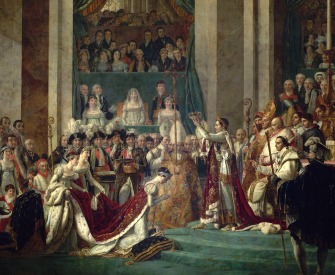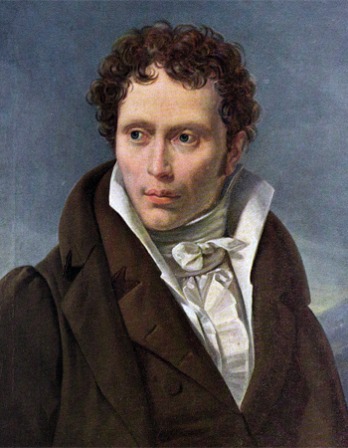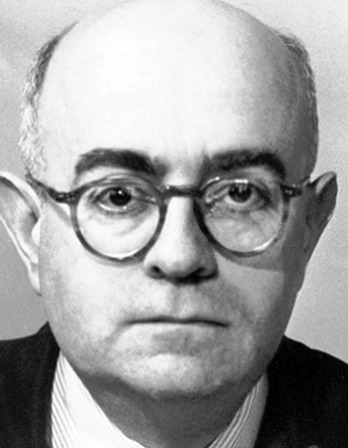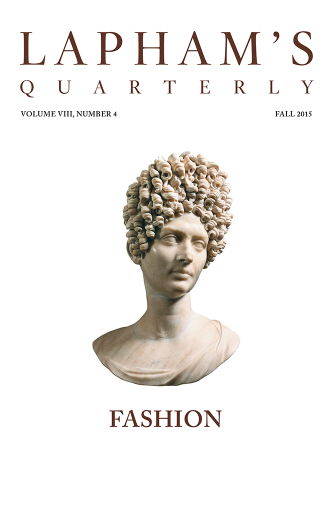A school without grades must have been concocted by someone who was drunk on nonalcoholic wine.
—Karl Kraus, 1909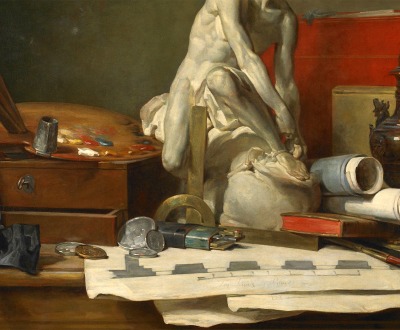
The Attributes of the Arts and the Rewards Which Are Accorded Them, by Jean-Baptiste-Siméon Chardin, 1766. Minneapolis Institute of Arts, Minneapolis, Minnesota.
In the West, the notion of “literacy” is inseparable from the growth of monasticism and church schools after the decay of the Roman Empire. To be “literate” signified the ability to read Scripture, to form letters on the page. This capacity, often rudimentary, defined the cleric and the clerk, these two designations being closely related. Some familiarity with Latin, though often in hybrid and transitional forms and, only very rarely, some access to classical Greek, via Byzantium or Islam, attached to ecclesiastical, legal, bureaucratic, and diplomatic dignities. Literacy thus defined a “clerisy” and those ideological and political power relations which made possible the governance of church and state. It is from this legacy, set out incomparably in Dante’s tracts on the vulgate and on literary education, that modern Western concepts of literacy and of its usages—where “modern” simply means postmedieval—derive.
This inheritance carried with it a blurring of the term “literacy.” It took on at least two principal significations. At its more elevated level, literacy came to stand for the shared communitas, for the shared code of reference of the learned. It pointed to their ownership of the material means of reading and writing. It came to underwrite—itself a suggestive term—the great age of the private library from Desiderius Erasmus and Michel de Montaigne to the mid-twentieth century. It comprised the producers and consumers of literature—note the source and content of that word—the lawmakers and divines, the scientists both natural and philosophical, the political thinkers and historians, the metaphysicians and the poets. Saint Jerome at his desk is iconic of that commonwealth of grammar. Belles-lettres, “bookmen,” and “readers” in the academic hierarchy (this rubric persists in British higher education to this day), correspondents in public and private affairs across the European civilitas, and women and men who could “write letters” are categories which illustrate the breadth and centrality of the word “literacy.” Very gradually, by reluctant osmosis, high culture and communicative techniques seeped downward. It influenced, in some measure, the rudimentary, often minimal capacities to read and write at all. Libraries became public; schooling expanded. In the wake of the Enlightenment, of the French and Industrial Revolutions, of Victorian didactic and social meliorism—consider the key functions of literacy in John Stuart Mill, in Matthew Arnold—and early models of the welfare state, literacy spread to the population at large. The role of printing and of printed matter, such as the cheap press, is both essential and conspicuous. But let us be careful. Even in this second, wider sense, literacy often was and indeed remains marginal. For generations, instruction remained elementary. The vast majority of the agricultural and laboring classes, women in domestic or menial employment, and early school leavers were literate in only the most superficial and restricted sense. At best, they could make out basic texts. Their writing skills were virtually inert. What books could they read, let alone own?
In tandem with the uneven deployment of literacy came the prodigious development of the sciences: theoretical and applied, pure and technological. But the definitive breakthrough can be ascribed to Galileo’s postulate that the language of nature, of reality in motion, when grasped and ordered by human reason, is that of mathematics.
Observing the imperialism of the mathematical in the sciences, in technology, in philosophic logic, and in the mechanization of our daily lives, one has the impression of an internalized dynamics and a drive for acquisition like no other. As Galileo and René Descartes professed, a body of knowledge—a gathering of data and insight—only ripens to being a science and a coherent discipline when it can to a greater or lesser degree be mathematicized.
One consequence has been the “two cultures” debate. It seems to me that in all the ill-tempered polemics which C.P. Snow initiated, an absolutely crucial point has been overlooked. The fundamental difference between the humanities and the sciences is the arrow of time. Virtually by definition, the sciences and technology move forward. Tomorrow is richer, more encompassing than today. New knowledge, new theoretical possibilities will be available next Monday. In the greater part of his enterprise the Western humanist looks ever backward. He studies; he teaches; he comments on the philosophies, the literatures, the music, the fine arts, and the history of the past. He celebrates the Bach anniversaries or the Mozart year. The humanities strive to quicken into renewed life the remembrance of things past. Logically, there is absolutely no reason why a new Shakespeare or Michelangelo or Ludwig van Beethoven should not appear on the scene tomorrow morning; why the next Johann Wolfgang von Goethe should not be drafting his unprecedented Faust in the high-rise apartment building next door. But how many of us, whatever our passions for modern, experimental art, truly believe in such epiphany? Resist, if you can, the seductions of facile pathos, of sunset in the vein of Oswald Spengler; dismiss Paul Valéry’s warning as to the mortality of our civilization; involve yourself receptively with conceptual art, with electronic and aleatory music, with postmodern writing. Still, the intuition gnaws: the humanities and arts in the West are virtuosities of twilight and recollection.
The reasons for this elude confident diagnosis. The phenomenon itself could be an optical illusion. Renaissance theorists told of incipient decline. But if there is sunset, it may point toward the eventuality that “tiredness” is a psychic and collective truth as well as a physiological fact. An enormity of past history weighs on Europe and on all that is archival in the American Eden. Bent over a blank page, John Keats puzzles how he can inscribe the word “tragedy” when Sophocles and Shakespeare are looking over his shoulder. Note the cunning of recuperation in so many of our twentieth-century masters. James Joyce enlists Homer; Pablo Picasso overtly anthologizes the unfolding of Western art from the cave paintings to Diego Velázquez and Édouard Manet; Igor Stravinsky plays metamorphic changes on Renaissance, baroque, and eighteenth-century templates. T.S. Eliot’s The Waste Land and Ezra Pound’s Cantos are terminal, almost frantic rushes to catalogue the past before the museum shuts down.
The hope of preserving or resuscitating humanistic literacy in any traditional mode seems to me illusory. Literacy—dominion of the classical—belonged to an elite. The democratization of schooling and political society runs counter to the Platonic ideals aimed for in the class divisions and power relations in education throughout the Ancien Régime or Victorian and Edwardian Britain. Receptivity to higher culture is far from natural or universal. It can be nurtured and multiplied, but only to a limited extent. The study of Greek irregular verbs or Horace’s metrics will always have engaged the few. In a more general, though not altogether evident sense, the ability to take in complex arguments—to respond to a Platonic dialogue, a tractate by Baruch Spinoza, a treatise by Kant, or a Shakespearean sonnet—characterizes a minority. This is true as well of the arts and of classical and modern music. A fog of political hypocrisy and pedagogic cant shrouds this entire issue. “Political correctness,” penitential submission to the rights of populism, make it virtually illicit to confront the deep-lying barriers which may separate the majority of men and women from access to the high places, to William Butler Yeats’ “monuments of unageing intellect.”
The inability of high culture to defend its corner effectively, what has been called “the treason of the clerics,” stems from a grim if often repressed insight. Twentieth-century barbarism burst from within the heartland of European civilization. It flourished in the very locale of aesthetic and philosophic merit. The death camps were built neither in the Gobi Desert nor in Equatorial Africa. And when barbarism challenged, the humanities, the arts, and much of philosophic inquiry proved impotent. What is worse, culture collaborated decoratively with despotism and massacre. There was many a lover of fine arts and classical music among the butchers, many a teacher of great literature among the sycophants. The mere designation “literae humaniores” now rings hollow.
“What, then, shall we do?” as Lenin famously asked.
Certain remedies lie to hand. Even the most efficient and devoted of schoolteachers are being systematically humiliated and prevented from doing their proper job by mountains of legalistic paperwork and coercive red tape. They are poorly remunerated and condescended to. The consequence has been an automatism of self-destruction. It is too often the least academically inspired who drift into secondary teaching, thus transmitting ftheir own saddened mediocrity to generations of bored pupils. It is a truism, long admitted, that neither the British A-levels nor the American high school curriculum—set in a matrix in which the basketball coach earns more than the math teacher—equips one for the modern world. Yet time after time, authentic reform—such as the adoption in the United Kingdom of an international baccalauréat to remedy the absurd contraction of vital skills, and to allow a grounding in both the humanities and the sciences—has been discouraged by special interests and an establishment frightened by innovation. Who can number the attempts to enforce in American schooling an attainment of genuine writing skills or some competence in foreign languages and numeracy? Such aims are wholly in reach of good sense and political will (Stalinism organized formidable levels of literacy, arithmetic capacities, and language learning by elevating teachers’ salaries and social status). None of this requires witchcraft.

Adam and Eve (detail), by Lucas Cranach the Elder, 1528. Uffizi Gallery, Florence, Italy.
If standards are to be reaffirmed, populist claims will have to yield to an order of merit in which genuine excellence can be distinguished from the mushroom growth of parasitic forms. All that is lacking is the political nerve which will expose and defy that disdain for intellectual life—that distrust of eminence characteristic of mass consumption in late capitalism. (One recalls the brief but intoxicating summons to education and intellectual adventure which lit the United States in the wake of the Soviet launching of Sputnik.) Again: we must acknowledge that human talents and the means for concentrated mental effort are unevenly distributed. Not every man and woman can ingest (Ben Jonson’s telling idiom) Immanuel Kant on synthetic a priori or a nonlinear equation. “Elite” means something very simple: it signifies that some things are finer than others, that no one is admitted to a physics department without mathematical competence, that Bob Dylan, entrancing as are his gifts, does not equal Keats. The Last Judgment will, I suspect, be a concours run by French examiners.
But as urgent and far-reaching as these issues are, they do not go to the heart of the matter, which is that of a fundamental literacy, a conceptual core for the women and men of today and tomorrow (“core curriculum” is a useful shorthand). By “literacy” I mean the ability to engage with, to respond to, what is most challenging and creative in our societies. To experience and contribute to the energies of informed debate. To distinguish the “news that stays news,” as Ezra Pound put it, from the tidal waves of ephemeral rubbish, superstition, irrationalism, and commercial exploitation. Can we draft such a central syllabus for both intellect and feeling? Can we sketch a “base” correspondent to the latent strengths of the imagination, a central axis of roused awareness interactive with the demands and fascination of the world?
The provisional suggestions I now put forward will seem utopian, perhaps scandalously so. But there are times of crisis in which only the utopian is realistic.
The eclipse of numeracy throughout our culture, the ignorance among those who regard themselves as educated in mathematical concepts and procedures, are at once a cliché and a misery. There is scarcely any constituent in the ways in which our world operates in which mathematical operations do not play a major role. It is not only nature which speaks mathematics; it is modern life. Yet the relevant elements are to a vast majority of us a rebarbative mystery or a dim recollection of school classes wretchedly taught and happily forgotten. Go around the room asking family or friends to define a “mean average.”
The loss extends far beyond the pragmatic. The rapacious, territorial, often sadistic mammal that is man has generated a handful of activities: constructs of consciousness which are nonutilitarian and of transcendent beauty. These “motions of spirit” (in Dante’s words) include music, poetry, metaphysics. Their origin remains a consoling enigma. Above all, they comprise pure mathematics. The debate as to whether mathematical abstractions have their validating counterpart in external reality as Plato held, or whether they are autonomous mental “play”—axiomatic games of mesmerizing depth and purity developed, as it were, from within—remains unresolved. This debate touches on what is most mysterious in the resources and dreams of the human psyche. What is not in doubt is the sheer beauty, the unfolding elegance, even, at certain points, the wit of the mathematical enterprise. To have encountered Euclid, as Edna St. Vincent Millay expressed it, is to have “looked on Beauty bare.” It is indeed in mathematics that Keats’ somewhat rhetorical equivalence between truth and beauty has its fulfillment. This “beauty,” however, has an exact, substantive meaning all but inaccessible to the nonnumerate, to all those who cannot take in what Leibniz intended when he opined that when “He sings to himself, God sings algebra.”
The prevalent view is that beyond rudimentary rote, mathematics can be imparted only to the specially gifted. The grim fact is that so much of the teaching is in the hands of the defeated, of those whose own attainments were wanting. Thus the feedback is negative and the spiral downward. Undoubtedly, there are innate, perhaps resistant differences between aptitudes to numeracy. But these have been grossly exaggerated. Hence my conviction that even advanced mathematical concepts can be made imaginatively compelling and demonstrable when they are presented historically. What must be set out is the intellectual and social history which lies behind them and which led to solutions or nonsolutions—the latter being perhaps the most fascinating and instructive category. It is via these great voyages and adventures of the human mind, so often charged with personal rivalries, passions, and frustrations—the argosy founders or gets trapped in the ice of the insoluble—that we nonmathematicians can look into a sovereign and decisive realm. Let me cite an example.
Prime numbers are the building blocks of our universe (“Only God,” said one great mathematician, “could have invented prime numbers”). Any alert child can begin to manipulate their magic. Developed in the 1860s by Bernhard Riemann and others, the Riemann hypothesis concerns the distribution of primes—we know their number to be infinite—and their relation to zero. The hypothesis is that this distribution can be mapped along a “ley line,” allowing one to predict where the next prime number will turn up. A pride of mathematicians, many of towering stature, set out to prove Riemann’s intuitively persuasive supposition. Their labors animated not only concentrated genius but personal rivalries of the fiercest kind. Again and again, proof has seemed tantalizingly close. Again and again, a flaw has been detected in the chain of demonstration. Proponents have sometimes suffered mental collapse and even suicide. As a recent historian of this enthralling saga puts it (he is himself an eminent pure mathematician), “Despite the best efforts of the greatest mathematical minds to explain the modulation and transformation of this mystical music, the primes remain an unanswered riddle. We still await the person whose name will live forever as the mathematician who made the primes sing.”
Locate this quest within its intellectual, historical, social, and even ideological fabric; rouse the child and the student to the inexhaustible fun and provocation of the unsolved; and you will have flung open doors on “seas of thought” deeper and more richly stocked than any on the globe.
The persistent interleaving of mathematical and musical terms and concepts—the assertion that “primes have music in them” —is no accident. From Pythagoras onward, it has been understood that the relations between music and number theory are organic. The immensely influential conceit of the “music of the spheres” buttressed Kepler’s conviction that the elliptical functions which govern planetary motions are of a musical order, that the rubric harmonia mundi has a perfectly empirical and demonstrable sense. Pythagoras, Kepler, and Gottfried Wilhelm Leibniz would have rejoiced in the designation as “background noise” of those radio waves which are now regarded as the vestiges and validation of the Big Bang which triggered our universe into being. Examine a Johannes Sebastian Bach canon or a Pierre Boulez score and their close affinities with algebraic codes and patterns become visible.
A whale ship was my Yale College and my Harvard.
—Herman Melville, 1851Numerous ethnic communities and traditions do not manifest what could justly be entitled “literature.” No society on earth, however “primitive,” however underprivileged economically or ecologically, exists without music. Musical notation, whether formally written down or not, is like that of arithmetic, a universal language far beyond the aspirations of any conceivable Esperanto. A hit tune will resound simultaneously in the backyards of Patagonia and the bars of Vladivostok. Electronic transmission through downloading and digital discs have boundlessly multiplied this planetary ubiquity. The languages of music need no translators (nor do those of calculus). Yet as obvious as is the role of music in individual and collective existence—how many of us would want to live without it?—so many riddles remain. To define music as organized sound is to beg the question. Can the often harmonious, syncopated sounds emitted by birds or by whales be defined as music in the proper sense? Is music singular to the human species? Intuition suggests that musical forms, even complex ones, preceded the evolution of speech. If so, how did they originate? Marxism adduces collective, choral emissions during shared labor. Claude Lévi-Strauss is more cautious: the invention of melody “is the supreme mystery in the sciences of man.” Each and every one of us—is there genuine tone-deafness?—will have experienced the power of music to seize upon our emotions, to quicken sorrow or joy, ferocity or tenderness, dynamic anticipation or nostalgia. How does music work inside us, what are its contiguities with our nervous system, with our innards? Why are we indifferent to tunes others find unforgettable? How can it be that identical compositions, such as Beethoven’s setting of Friedrich Schiller’s “Ode to Joy,” can serve as anthems for totally opposed political and ideological movements? First and foremost, there is the semantic crux. Music and compositions are charged with meaning. But when we seek to articulate this meaning, to paraphrase it verbally, the result is either vaguely metaphoric or of a desperate banality. Only program music is translatable. Music is meaningful in the extreme. For many of us it comes closer than any other human happening to communicating the possible proximity of the transcendent. But strictly considered, it has no sense. In essence, its overwhelming force is useless. It is this potent nonutility which exasperated and worried Plato; it is this anarchic “unemployment” which made him restrict music to athletic and military functions in the ideal polis.
Learning to sing or play an instrument within the bounds of one’s natural endowments—the most brilliant living percussionist is deaf—is a formidable enhancement of both psychic and social resources. Music can be the therapy of the hurt spirit also, as has long been suspected, in a medical perspective. To understand music is to be confronted with the surprisingly confining limits of language. Only dance, perhaps, can explicate music. Asked to explain a difficult étude, Robert Schumann simply played it a second, then a third time. Now it is precisely this utter presence beyond verbal paraphrase or proof, beyond logical diagnosis, which seems to attach to the “borderline” but immensely significant phenomena of religious belief, of eros and of death. Pace Ludwig Wittgenstein, the limits of language are not those of my world. Friedrich Nietzsche saw much deeper when he defined music as the mysterium tremendum of the unfathomably obvious.
Architecture has been called “frozen music.” It has also been described as “geometry in motion.” The kinship between music and architecture is celebrated in classical mythology and practice. Music attends the founding of cities. Flutes resound as the Athenians erect the walls of the Piraeus; Thebes arises to the tune of Arion’s lyre. As Valéry has it in his Platonic dialogue on architecture, the purpose of the architect is to “redistribute [light], endowed with intelligible forms and almost musical properties, into the space where mortals move.” To those who have been taught to listen, “a facade can sing.” In both architecture and music, essential aspects of harmony, proportions, and thematic variation are related. In turn, these aspects are fundamentally geometric and algebraic. Numerical harmonics generate their beauty and their truth. The animate temple, observes Valéry, “is the mathematical image of a girl of Corinth.” In a manner far surpassing simile, divine creation is, in creation myths across the planet and in Plato’s Timaeus, the deed of a supreme architect, of a master builder. (Cross reference: Henrik Ibsen’s ironic reprise of this motif.) The compass and the plumb line are the symbols of the cosmic blueprint.
Today we are in one of the stellar periods of architecture in all history. Public and private buildings, bridges of stunning beauty and innovation, are being built all over the globe. The relevant theoretical considerations and techniques extend from geology, material sciences, engineering, and design to higher mathematics. They engage economics and social planning, transport, urbanization, and ecology in its most urgent and embracing horizons. To be initiated into the functions of architecture in contemporary life is to encounter cardinal dilemmas in the state of our cities, our mobility, and what ideals we may still harbor as to social justice and healthcare. Having witnessed so much violent destruction, having seen the tragic fragility of our proudest towers, we are now in a fever of construction which, despite etymology, is often anything but edification. It is, furthermore, in today’s architecture that we engage with the computer at its most creative. There is architecture before the computer and after. The borderline and transition can be exemplified by the differences between the as yet experimental, tactile mathematics of the Sydney Opera House and the computer-generated, computer-controlled marvels of the Guggenheim Museum in Bilbao or the Jewish Museum in Berlin. In both these cases, design and realization would not have been feasible without high-power holographic modeling and exact computation. “Give the gold medal to the computer,” quipped Frank Gehry when describing his Bilbao project. In correlation, electronic music is emitted to “argue,” to activate the conceptual spaces in the access to the Tate Modern in London. To be taught to “read” a building is to be made literate in respect of much that is most beautiful and expressive in modernity.
If the heavens were all parchment, and the trees of the forest all pens, and every human being were a scribe, it would still be impossible to record all that I have learned from my teachers.
—Jochanan ben Zakkai, 75The fourth synapse in our core literacy, in the new quadrivium, would be an introduction to molecular biology and genetics. The veritable explosion of these disciplines since the mapping of DNA and its double helix is altering the texture of private and public affairs. Cloning, the creation of self-replicating molecules in vitro, the genome projects, the potential transplant of vital organs—including memory—are and will be of such consequence as to generate mutations in the human condition. What facet of ethics, law, demography, or social policy will be immune to these reorganizations of bodily life and consciousness? Every question as to personal responsibility, identity, the life span, the right to program heredity, the limits of state intervention in the determination of gender (for military ends), and the arrest of genetic malformations is being reformulated. In the most sober perspective, the horizons of being are made to seem unbounded yet also full of menace. Responsible awareness will need access, albeit at an introductory level, to the concepts of the new alchemy. Otherwise women and men will be excluded from indispensable political, social, and personal debates. Already, the controversies raging over therapeutic abortion, euthanasia, cloning, and “eugenic” manipulations demand from the layman, so intensely implicated, a considerable sophistication. To echo the old maxim: the life sciences are far too serious to be left to the scientists. The caring layman will have to do some homework if his or her voice is to be heard. Already, fundamentalist censorship and the political appeal to raucous ignorance demonstrate the urgency of the problem and the imperative need for some measure of biological-genetic literacy.
A central curriculum in mathematics, music, architecture, and the life sciences—taught, wherever possible, historically. These four axes open sensibility to both the most immediate challenges and the outermost reaches of thought. Strikingly, they also embody an incommensurable potential for fun, play, and aesthetic delight. Homo ludens is enlisted to the turbulent heart of his being. To discern wit in mathematics, humor in music (Franz Joseph Haydn, Erik Satie), playfulness in architecture—that gherkin over London—or the sheer loveliness of certain molecular structures, is to participate in a pedagogy for hope. No man or woman should feel themselves to be literate in this new millennium without some grasp of a nonlinear equation; without some intimation of how music speaks its world language; without some recognition of the issues at stake—aesthetic and practical, formal, and political—when a new building mushrooms on the horizon; and without some feel for the biogenetic reshaping of our identity (Aristotle’s or Descartes’ ego is no longer ours). How else can we be at home, or even an informed guest in what Martin Heidegger has called “the house of being”?
Literacy as numerate, musical, architectural, and biogenetic. A mad project. I only wish it were more so.
